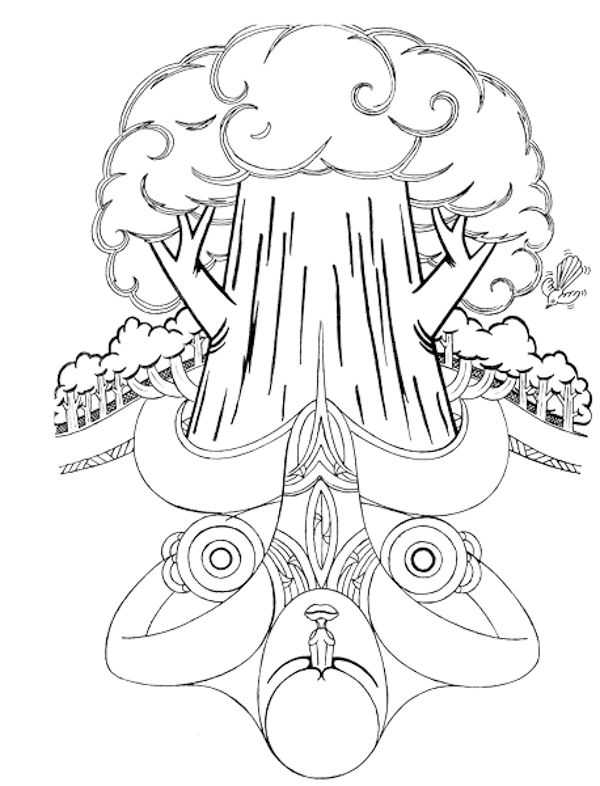
Tānemahuta - The forest and all that dwells in it. Qualities of growth, strength, shelter, diversity of life.
Te Aratiatia Community Marae was the perfect venue for holding the term 4 2020 Waikato Enviroschools biodiversity workshop. The marae sits within the Fairfield College campus and backs onto the Kukutaruhe gully and stream. The “Fairfield Project” based here has a vision to develop, at Fairfield College, an Ecological and Environmental Educational Centre with a focus on, and commitment to, sustainable practice and living.
The group of visitors were welcomed on to Te Aratiatia and provided with stories about this most unique marae built by Tainui master carver Kereti Rautangata. This helped set the scene for a day immersed in the Living Landscapes theme area of Enviroschools and local curriculum.

Learning from each other.
Participants also heard about the Fairfield Project and restoration work that is part of it. The project, started in 2017, is really making a name for itself as a hub for re-generative practices, workshops and working-bees in Kirikiriroa/ Hamilton.
The gully has become home to one of only two stable Tui breeding populations in the city. NIWA (National Institute for Water and Atmosphere) who regularly monitors the stream in the gully, recently discovered the first spawning site for the Giant Kokopu in New Zealand in the Kukutaruhe stream.
Visitors also learnt that Kukutaruhe translates as kuku (native pigeon) and taruhe (flight path), referring to the flocks of kuku (kereru) that once flew in this area. The kuku are now rare visitors to Kirikiriroa – but there is a vision that one day they will return.
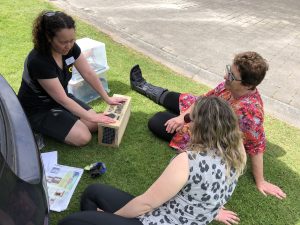
Karen from Predator Free explains the construction of the traps.
Teachers from Waikato Enviroschools (ECE, Primary and Secondary) joined forces with community facilitators and coordinators to focus on building a group pool of knowledge/ puna mātauranga of biodiversity and restoration education. They engaged in activities that helped connect with place and nature and heard different perspectives from people working in this kaupapa.
The day was punctuated by facilitators modelling experiential activities. Part of the workshop had participants consider different pedagogical approaches and curriculum links (Te Whāriki and NZC) where appropriate for teaching and learning in, about and for local biodiversity.
Enviroschools Waikato team worked together with Lyn Rogers, the Coordinator of the Fairfield Project to organise the day. They recognised that the rich sharing and learning would not have happened without the collaboration of a diverse group of people who helped contribute to the success of the day.
“Very knowledgeable experts from all sorts of fields” – participant feedback.
A plenary session in the wharenui gave the audience ‘The Big Picture’ with Catherine Kirby, Research Officer, Environmental Research Institute, University of Waikato sharing ‘What is Biodiversity and Why is it important’. She talked about ‘the weave’, how everything is connected, and that there are knots between the weaves. She reminded everyone just how awesome biodiversity is.
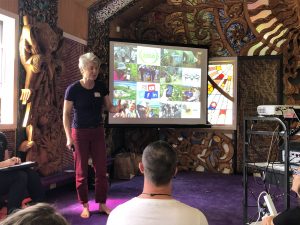
Monica shares her extensive knowledge and enthusiasm about citizen science.
Marina Hape, of Waikato Tainui and Kukutaruhe Education shared a Mātauranga Māori perspective whilst Jane Wheeler from the Department of Conservation talked about the Community Conservation Education Model inspiring the audience and getting them to recognise what’s possible through community education. Citizen science guru Dr Monica Peters outlined opportunities for young people and communities to engage with real science through biodiversity projects.
“Having a whole day of having experts and contacts in one place allowed fast transfer of knowledge.” – highlight for one participant.
On a field trip in Kukutaruhe Gully, NIWA’s Dr Paul Franklin showed participants the spawning ground of the Giant Kokopu – somewhat ironically protected by weeds Trandescantia and blackberry (and causing a bit of tension for the gully’s avid weeders!)
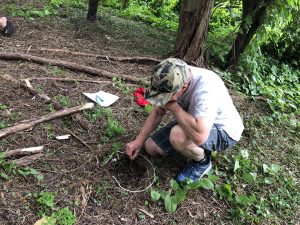
Observations in the gully.
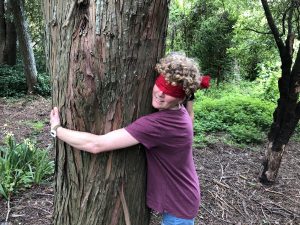
Kia ora, e rakau. Sensory activities helping connect people with nature.
A short bus trip was taken to near-by Hukanui School. This provided an opportunity to hear about a community project in an arm of the Kirikiriroa gully that has been going for over 20 years and has involved many students from the school. This successful gully restoration project started in 2001 and has made a significant impact on both biodiversity of the gully and opportunities for student learning. The school has its own plant nursery and a group of students volunteer their time to source seeds for propagation and on-growing plants as well as planting and maintaining the gully. Experienced Enviroschools lead teacher, Michelle White, explained how using the Enviroschools Action Learning Cycle was part of their school pedagogy and that learning about local biodiversity was an important inroad into sustainable practices and more complicated sustainability issues.
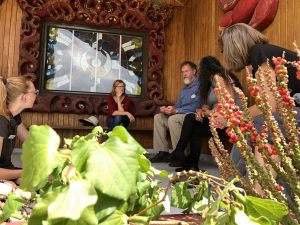
Wayne talks passionately about sourcing seeds from plants local to restoration sites.
A range of short workshops in the afternoon allowed participants to get a taste of, and consider where to start with biodiversity restoration, with Ecologist, Bruce MacKay, and Enviroschools facilitator, Adrienne Grant, sharing ideas on ‘How to Grow a Forest’. Eco-sourcing expert Wayne Bennett from Forest Flora discussed seed collection and propagation and Karen Barlow from Predator Free Hamilton talked about pest control, while the group put together their own rat trap boxes to take away.
Andrea Soanes, online resource developer from Science Learning Hub shared some of their special resources available to schools; Enviroschools facilitator, Anna Cunningham, explored experiential nature activities and Lyn Rogers explored Biodiversity and the Curriculum.
“Everything is connected, and those teachable moments are so important.” – comment from participant.
Organisers hoped that an outcome from the workshop would be that educators were more empowered to enable greater engagement in action for the local environment. From the feedback received it seems this was achieved. Enviroschools facilitators have since heard that teachers went away very inspired. Netherton School in Hauraki and St Paul’s Catholic School in Ngāruawāhia are looking for ways to join forces with local community restoration groups. Maeroa Intermediate School in Hamilton immediately placed tracking tunnels and started creating bug hotels as part of their gully restoration.
“Combined action plan with a school in the local area to ‘Green the Plains’. Next year – long term plan/ project.” – participant setting future actions at the end of the workshop.
Banner photo: Whakawhanaunga outside Te Aratiatia marae.
